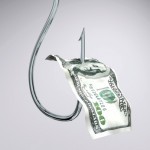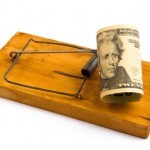![Environmentalism: A Cult with a Ponzi Scheme]()
by Steven Waechter | Jul 11, 2011
 A long time ago, somebody figured out that people were afraid of nature. With this realization, our subject set out to carve a statue of a woman with a horned head dress, and declared the idol to be Ninhursag, the goddess of the earth. Our carver then set about convincing people that if they brought their best wheat, their best grapes, and their best lambs and calves to sacrifice to the goddess then they will be blessed with plenty and the grace of the divine goddess will rain down upon them, but if they refused they would be cursed with pestilence.
A long time ago, somebody figured out that people were afraid of nature. With this realization, our subject set out to carve a statue of a woman with a horned head dress, and declared the idol to be Ninhursag, the goddess of the earth. Our carver then set about convincing people that if they brought their best wheat, their best grapes, and their best lambs and calves to sacrifice to the goddess then they will be blessed with plenty and the grace of the divine goddess will rain down upon them, but if they refused they would be cursed with pestilence.
And thus the people, rending their garments and lamenting of their fear of the weather and their invented devil gods, brought their best produce to their idols, making themselves poorer and their lives more difficult all out of superstition and fear of their world.
It grew into dogma – everybody knew that sacrifices to the idols was a necessary step to ensure survival of the community and the individual alike.
Of course, modern humanity has advanced light-years beyond these petty superstitions. We don’t fear natural phenomena; we fear a chemical element – carbon.
Enter the global climate change movement, who has informed us that driving cars, using electricity and having children (or as Prince Philip called them, Carbon Bombs,) are all causing massive expulsions of carbon dioxide into our atmosphere, and that if it continued, the seas would rise, hurricanes and other storms would run rampant, crops would wilt and famine would choke all the lands everywhere.
It has turned into a dogma – everybody knows that carbon dioxide from human activity will destroy all the world with global warming and floods, droughts, heat, cold, etc…
Therefore we the peasants must be constrained in our “carbon footprints,†with higher taxes on gasoline, electricity, natural gas, food, clothing, babies and every other trapping of ordinary life.
So, instead of sacrificing your standard of living to a god, you can sacrifice your standard of living to government.
Of course, if you feel uniquely guilty about your existence, you can sacrifice a larger portion of your income through the purchase of carbon offsets; plenary indulgences guaranteeing your place in green heaven regardless of what you do in your everyday life, and the carvers of the environmentalist gods are standing ready to accept your offering.
They also have no more power over the climate as the carved idols of primitive cultures, but they will take your hard-earned wealth if they can convince you that your sacrifices are for the greater good by means of gratifying the new climate goddess.
The environmentalist cult has even threatened “climate change deniers,†going so far as calling for systematic punishment of those who publicly disagree with the climate change agenda. One Australian commentator even called for forcible tattooing of climate change skeptics. Our self-appointed betters aren’t above sending heretics to the dungeons as it turns out.
Under the climate change regime, progress is renamed destruction, poverty assumes the name “sustainable development,†and naturally there are huge profits to be made by the prophets of the new nature worship; and a horde of people line up to sacrifice wealth and liberty out of fear and without receiving anything in return.
So, go surrender your freedom, your mobility, your red meat and your air conditioning to the new Ninhursag if you wish. I’ll burn a pile of tires in honor of Kali the Destroyer, and we’ll see what happens.




by Steven Waechter | Jul 1, 2011
 Much attention has been focused on the size of the national debt as a whole; roughly $14.4 trillion. That number is astonishing, but the sheer size of the debt actually hides the true horror which is in store for the economy and future generations.
Much attention has been focused on the size of the national debt as a whole; roughly $14.4 trillion. That number is astonishing, but the sheer size of the debt actually hides the true horror which is in store for the economy and future generations.
The debt has many component categories, the largest of which is called Marketable Debt. That means the portion of the debt that was issued in treasury securities that can be sold in the secondary bond market, and it is around $9.2 trillion. The rest is Non-marketable, and held mainly by the Social Security Administration through bonds that cannot be sold.
The Marketable Debt also has its own sub-components, based on the type of security that was sold to incur the debt in the first place. Treasury Bills mature in 1 year or less and accrue interest; Treasury Notes mature in 2, 3, 5, 7 or 10 years, and Bonds mature in 30 years – and the Notes and Bonds pay coupon interest every six months. Each bond is sold at the prevailing interest rate at the time of the sale.
Here is the part that is frightening: Starting under President Clinton, expanding under Bush, and exploding under Obama, the federal government has shifted its borrowing from traditional 30-year Bonds to the shorter term securities.
According to the US Department of the Treasury’s Monthly Statement of Public Debt dated May 31, 2011, of the $9.2 trillion dollars of Marketable Debt, only about $965 billion are 30-year Bonds. More than $6 trillion are on Notes, with maturities ranging from 2 to 10 years, and a whopping $1.5 trillion are on 1-year Bills.
We are running record deficits, so we aren’t paying any of these off when they mature – we just roll them over onto new securities. We’re also adding another $1.6 trillion on to the pile.
Right now the Federal Reserve is fixing interest rates at levels so low that they cannot be maintained forever. When the Fed raised interest rates to more than 20% back in the 1979-82 recession, the Treasury actually sold some bonds at interest rates of 20% or higher. Imagine if interest rates went up to just 10% today, and stayed there for a couple of years. All of those Bills and Notes that mature and are rolled over will roll over to higher interest rates.
The interest payments alone will easily top $700 billion dollars a year, and since the debt is likely to grow further as interest rates go up, the country is likely to pay well over $1 trillion per year in coupon interest alone -which will be financed by the issuance of new Treasury Notes.
Imagine a world where the Army is disbanded, Medicare covers only critical care needs, the Social Security age is retroactively raised to 75, and the all retired government officials lose their pensions because the United States needs to dedicate so much of its budget to paying the interest on the debt. These are politically impossible measures.
The only other way to avoid direct default is to print money – destroying the nation’s economy with hyperinflation but technically making the interest payments, albeit with dollars devalued to near worthlessness. That’s how the Federal Reserve managed to keep interest rates so low up to this point – by buying Treasuries at artificially low interest rates with printed money. That is why Bill Gross of PIMCO dumped every piece of US Treasury paper his hedge fund owned – the returns on these bonds would have been eaten up by inflation.
There it is – either we ruin the dollar or we default. Default is by far the better option; we can restructure our debts to something more manageable. This will ruin our credit rating forever, so future politicians will not be able to run deficits for vote-buying projects and illegal “Kinetic Military Actions,†whatever those are. There are silver linings everywhere.
![Environmentalism: A Cult with a Ponzi Scheme]()
by Steven Waechter | Jun 21, 2011
 Around the corner from my former apartment in Newton was a house that was taken in foreclosure. The “For Sale†sign had been there for a very long time, the lawn wasn’t mowed regularly and the shrubs had died in the winter but hadn’t been removed.
Around the corner from my former apartment in Newton was a house that was taken in foreclosure. The “For Sale†sign had been there for a very long time, the lawn wasn’t mowed regularly and the shrubs had died in the winter but hadn’t been removed.
Walk around your own neighborhood and see how many houses are for sale. Sometimes the sign openly states that it is bank-owned, other times you might have to search on the county assessors website. There are plenty of bank-owned houses in Iowa; there are many, many more in California, Nevada, Michigan and Illinois.
The point is this: With such a large supply of bank-owned houses, of course houses will continue to fall in price. When a store has excess inventory, they need to have a discount sale to get rid of it, the same is true for houses, and banks are taking more houses every day.
Banks live and die by their balance sheets. If a bank has the cash to keep these houses in their possession, hoping that the prices will stabilize and that they can sell at prices that allow the banks to recover the unpaid mortgage, then they will keep on trying to sell houses in the usual retail market. As soon as a bank runs short of cash, or can no longer carry the costs of the property taxes and the maintenance for all these houses, they will sell their houses at fire-sale prices, probably even at auction. No reserve bids, the highest price gets the house free and clear.
This should have happened back in 2009-2010. Banks, short on cash and overloaded on houses and notes for houses, would have had to dump them for whatever they could get. This would have caused a sharp decline in housing prices, but as the houses were sold and put back to work – the job of a house is to shelter people – the supply would have been worked through and housing prices would have recovered and stabilized in relatively short order.
And then came the TARP bailout. The federal government gave billions of dollars in checks to the banks, giving them a “capital injection†– putting cash on their balance sheets – hoping that the banks would lend it out. They didn’t. They kept it in cash, and were able to carry thousands of foreclosed homes on their books through the crunch of 2009-2010.
Instead of a flash drop followed by a recovery, the American homeowner was “spared†a deep but short fall in home prices and instead have been subjected to this long, slow death march of declining home equity. The decline we got may have been slower, but it will be longer, guaranteeing that more private home owners will be forced – by a bad economy, relocation, or retirement – to try and sell their most expensive asset in a market that is still actively falling. As for potential buyers, the odds are that the longer they hold off making a purchase, the better deal they will get.
If we had skipped TARP, then this glut of houses would have been worked through by now, sold at auction either by the banks or by the bankruptcy trustees of the banks that didn’t get the message of the markets.
Politicians that supported TARP are still finding ways to rationalize it. “We needed to preserve the financial system.†“We needed to prevent chaos,†and on, and on, and on. All they achieved was to prevent real bargains and guarantee continued oversupply. They need to be held accountable for their support of that pathetic misstep passed under the cover of hysterics.
style=’clear:both’>

by Steven Waechter | Jun 13, 2011
 Imagine a plot of land in the desert, consisting only of mesquite scrub and dust. If you assembled a system of sprinklers on this desert land, and ran them heavily enough, you could make the desert green with grass, corn, or even water loving willow trees. But then the water supply you are stealing from runs dry, and the sprinklers sit there, idle. The greenery of your efforts wilts, dies and turns to dust.
Imagine a plot of land in the desert, consisting only of mesquite scrub and dust. If you assembled a system of sprinklers on this desert land, and ran them heavily enough, you could make the desert green with grass, corn, or even water loving willow trees. But then the water supply you are stealing from runs dry, and the sprinklers sit there, idle. The greenery of your efforts wilts, dies and turns to dust.
This is the story of government stimulus. First, the federal government stole – yes, I said stole – hundreds of billions of dollars to bail out first the banks, and then General Motors, and then spend hundreds of billions more on the President’s stimulus package, which promised to reignite the economy, fight of the recession, and reduce unemployment. The federal government crowded out private borrowers from the capital markets with their enormous deficits, damaging other sectors of the economy – but no matter. The stimulus program would create or “save†jobs elsewhere, making the whole thing worth while, somehow.
It didn’t work. It was never going to work. All we were left with was another economic bubble; this one not in stocks or in housing, but in government spending. Now, the cash supporting this situation – the air inflating the bubble – is being printed, at the cost of inflation and rising prices on everything; essentially theft through increased costs of living. Consumer spending is shifting to cover the increased costs of food and fuel, to the detriment of other goods and services.
As it became an obvious failure, the first impulse was to double down with another stimulus program – digging a deeper well. But not this time; the wealth of the country was depleted, the water was gone.
Now, we stand at the beginning of the double-dip recession – a recession within the depression that was born from the last recession. This time there is no way out and no way to delay. The economy as a whole can no longer afford to supply the cash to keep the government spending bubble inflated, a bubble that never should have existed in the first place.
It is time for the economy to be purged of all the mal-investments of both government and business and finally rebalance itself, something which it has not had a chance to do. Government stimulus was doomed from the beginning because it only stimulated a portion of the economy that depended entirely upon government money; the rest of the economy was damaged by this, not improved by it, and governments can, in fact, run out of money.
The next phase of the recession will be more painful than the first; with an economy that has been further weakened and a government lacking the resources to do much of anything, the next big dip is going to be one for the history books – which is terrifying.
![Environmentalism: A Cult with a Ponzi Scheme]()
by Steven Waechter | Jun 6, 2011
 At barely five feet tall and armed only with a Ph.D in economics, Milton Friedman hardly had the look of a hero set out to save a nation. Yet, Professor Friedman predicted with near perfection the disastrous economic situation the United States is enduring today. He did this with a simple idea – the Quantity Theory of Money.
At barely five feet tall and armed only with a Ph.D in economics, Milton Friedman hardly had the look of a hero set out to save a nation. Yet, Professor Friedman predicted with near perfection the disastrous economic situation the United States is enduring today. He did this with a simple idea – the Quantity Theory of Money.
MV = PQ. This is the simple mathematical formula which explains the death of American prosperity. Where M is the supply of money, V is the velocity that it circulates, P is prices, and Q is the quantity of transactions. Simply put, if the government prints more money, prices go up unless the number of transactions also increases. Too many dollars chasing too few goods, as they say, leads to inflation.
Enter Quantitative Easing, where the Federal Reserve buys government bonds with money that it printed specifically for the purpose of buying government bonds. This is the only way our government can run $1.6 trillion deficits – which, according to President Obama we must do for the next ten years. The bond market would never absorb this many bonds at interest rates this low unless the Federal Reserve were rigging the market, and in recent months they have been purchasing roughly 70% of federal bonds being offered. The money raised is immediately spent by the federal government, sharply increasing both the supply and velocity of money. In 2000, there was approximately $4.7 trillion US Dollars in circulation, now there are nearly $10 trillion.
The quantity of transactions is going down. Don’t take my word for it, either. Look around your neighborhood for all of the houses that have been for sale for months, all the vacant office space, and all the closed restaurants. These are all a component of the decline in the quantity of transactions. Fewer houses bought, fewer goods sold, fewer meals consumed.
Which leaves us with one last variable: Prices. With double the dollars in circulation, being spent by the government as quickly as they can print them, and with fewer transactions in the overall economy, prices must simply explode.
Pull out your old check records or bank statements, and see what you used to spend on groceries and gasoline, and compare them to what you are spending now. The increase is not the cause of supply problems, speculators or gouging: It is inflation, pure and simple.
The end result has been an inflationary depression, with increasing prices and high unemployment. What the country desperately needs is a sound dollar, stable prices and, of course, a sound fiscal policy based on a balanced budget. Thus, fiscal and monetary policies are inextricably linked, with our deficits leading to inflation and inflation making the deficits possible.
Left-wing ideologues like to repeat the old trope that in America the poor get poorer and the rich get richer. Well, sad to say, it is true. But, it is not capitalism that is doing the pillaging; it is our own government. Rising prices means lowering standards of living. Despite the messianic rhetoric of Mr. Obama, it is his deficits, financed by Mr. Bernanke’s printing press, that are robbing the pensioners and the working class of their standard of living.
The Republican that can best articulate this message, without being pulled into the weeds, will take the Presidency—or at least get my respect.



 A long time ago, somebody figured out that people were afraid of nature. With this realization, our subject set out to carve a statue of a woman with a horned head dress, and declared the idol to be Ninhursag, the goddess of the earth. Our carver then set about convincing people that if they brought their best wheat, their best grapes, and their best lambs and calves to sacrifice to the goddess then they will be blessed with plenty and the grace of the divine goddess will rain down upon them, but if they refused they would be cursed with pestilence.
A long time ago, somebody figured out that people were afraid of nature. With this realization, our subject set out to carve a statue of a woman with a horned head dress, and declared the idol to be Ninhursag, the goddess of the earth. Our carver then set about convincing people that if they brought their best wheat, their best grapes, and their best lambs and calves to sacrifice to the goddess then they will be blessed with plenty and the grace of the divine goddess will rain down upon them, but if they refused they would be cursed with pestilence.




